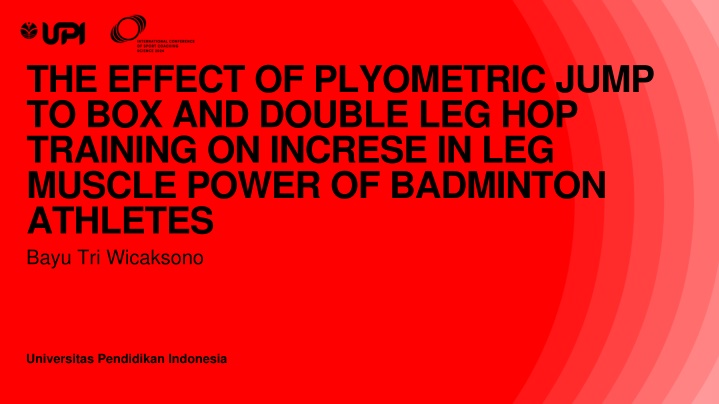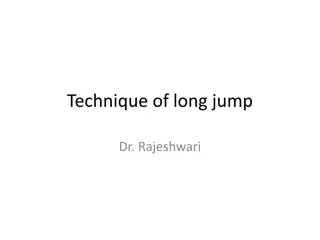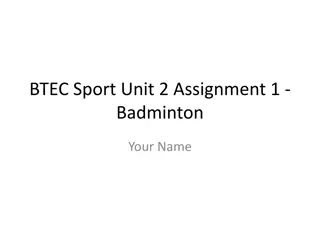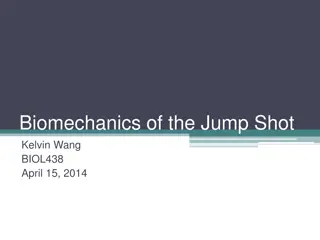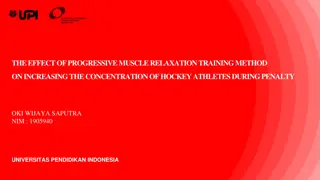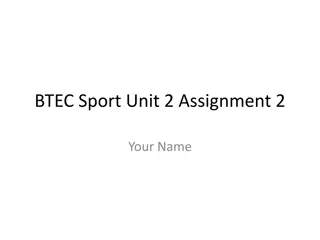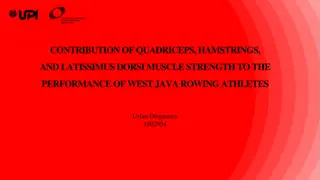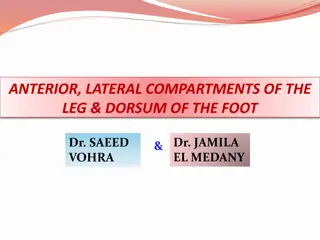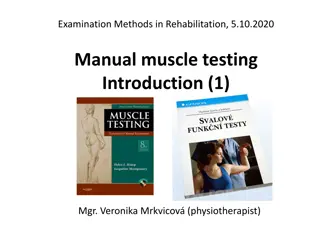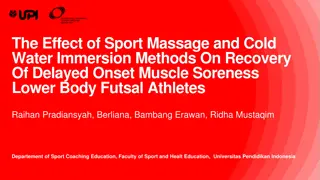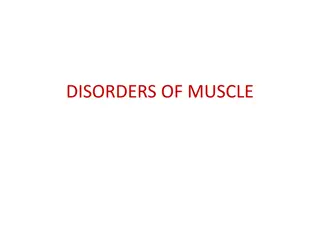Impact of Plyometric Jump Training on Leg Muscle Power in Badminton Athletes
Plyometric jump to box and double leg hop training can significantly improve leg muscle power in badminton athletes, enhancing their ability to execute powerful smashes. This study focuses on the effects of specific plyometric exercises on leg strength essential for optimal badminton performance. The experimental research design involves athletes from PB Kurniawan Fortune Badminton Club, using a pretest-posttest control group design to measure the outcomes. The goal is to enhance athletes' leg muscle power through targeted training methods.
Download Presentation

Please find below an Image/Link to download the presentation.
The content on the website is provided AS IS for your information and personal use only. It may not be sold, licensed, or shared on other websites without obtaining consent from the author.If you encounter any issues during the download, it is possible that the publisher has removed the file from their server.
You are allowed to download the files provided on this website for personal or commercial use, subject to the condition that they are used lawfully. All files are the property of their respective owners.
The content on the website is provided AS IS for your information and personal use only. It may not be sold, licensed, or shared on other websites without obtaining consent from the author.
E N D
Presentation Transcript
THE EFFECT OF PLYOMETRIC JUMP TO BOX AND DOUBLE LEG HOP TRAINING ON INCRESE IN LEG MUSCLE POWER OF BADMINTON ATHLETES Bayu Tri Wicaksono Universitas Pendidikan Indonesia
INTRODUCTION Badminton is one of the most famous sports in the world. This sport attracts all age groups, and various skill levels of men and women are evident in the emergence of badminton clubs ranging from regional to national levels. According to Subarjah (2011), in general, the basic skills of badminton games can be grouped into four parts, namely how to hold the racket (grips), stance, footwork, and strokes. Hitting motion in badminton games is categorized into three types. This category is based on the time of the stroke. The three types of strokes are strokes with racquet swings from below (underarm strokes), sidearm strokes, and overhead strokes. These three hitting movements produce several hitting techniques, such as serving, netting, lob, drive, drop shot, smash, and clear. According to Sapta Kunta (2010), "smash is an overhead blow that is directed downwards by relying on the full strength and speed of the arm and wrist". It can be concluded that smash is a sharp and fast-hitting technique. To hit smash well, athletes need good mastery of technique, physical condition, and mental and stable emotions. The physical condition abilities needed in doing smash include arm muscle power, leg muscle power, endurance, flexibility, and agility. One of the physical conditions used when hitting a smash is leg muscle power. A smash hit is done by jumping, also called a jumping smash. Bayu Tri Wicaksono, 08 Agustus 2024
INTRODUCTION To get good leg muscle power, of course, it must be accompanied by training; there are many forms of training to train the strength of leg muscle power, one of which is plyometric training. According to Chu and Myer (2013), "plyometric training is an exercise technique used by athletes in all types of sports, to increase strength and explosive power". The forms of plyometric training include depth jump, squat jump, squat trush, hop jump, jump to box, hurdle jump, jump rope, and running up and down stairs. However, in this study, the researchers chose the jump- to-box and double-leg hop jump because these two forms of plyometric exercise are not so complicated in their implementation and do not require facilities that are difficult to obtain. Plyometric training is hoped to increase leg muscle power, where the failure often experienced by athletes when jumping smash is influenced by several factors, one of which is leg muscle power. Leg muscle power will affect the height of the jump when jumping smash. This research was taken from previous research by Yayang, S. (2020), where the research also used the same training method, namely plyometric, but with different forms of training and research places where previous studies using the form of drop jump training and side to side box shuffle which was carried out at UKM badminton university of Malang, while the research to be conducted by the author uses the form of jump to box training and double leg hop jump which will be held at club PB Kurniawan fortune badminton club Serang City. Bayu Tri Wicaksono, 08 Agustus 2024
METHODS Method Used is the experimental method. Design Research design The Two-Group Pretest-Posttest Design. Gambar 3. 1 Pretest - Posstest Control Group Design Instrument Vertical Jump Test. Population Athletes from PB Kurniawan fortune badminton club. Sampling The technique used is purposive sampling with the criteria that the subject is 13-18 years old and the subject has mastered the jumping smash technique. Bayu Tri Wicaksono, 08 Agustus 2024
Sig. (2- tailed) RESULTS Kesimpu lan Interpretation in Table 1. paired sample test data shows a sig value of 0.000 < 0.05, which means that the variable influences dependent variable. influences the increase of leg muscle power in badminton. At the same time, the paired sample test data shows a sig value of 0.000 < 0.05, which means that plyometric double training influences increasing leg muscle power badminton. Furthermore, independent sample plyometric jump-to-box on improving badminton leg muscle power can be seen in Table 3. below. Kel. Data t F. Jump to box Double leg hop Terdapa t Perbeda an The paired sample test was used to determine whether there were differences in leg muscle power before and after training in each group. Significance level < 0.05. The paired sample test jump-to-box results can be seen in Table 1. below. 0.934 0.000 3.678 independent the also It Tabel 3. Uji independent sampel t-test. The independent data shows value of 0.000 < 0.05, which means there between the two variables. Data on plyometric training and plyometric double- leg hop training show differences with a Sig value. (2-tailed) 0.000 < 0.05 so that there is a difference plyometric jump-to-box training method and plyometric training on increasing the results of leg muscle power in badminton sports sample Sig. test a (2-tailed) Kesimpula n Group t Sig. N is a difference Jump to Box Tabel 1. Uji paired sampel test jump-to-box. 6,143 0,000 6 Signifikan jump-to-box leg hop results in Group t Sig. N Kesimpulan the of Double Leg Hop test training results between the 13,416 0,000 6 Signifikan the of double leg hop Tabel 2. Uji paired sampel test double-Leg Hop. Bayu Tri Wicaksono, 08 Agustus 2024
Double leg hop training can build leg muscle toughness, which will help badminton athletes perform higher and faster jumping movements. In addition, double leg hop training can also help develop leg muscle toughness, which will help badminton athletes movements better. In general, double leg hop training can be done in the form of standard training, where athletes perform movements that begin with an upright attitude, then perform a jumping movement with two legs until the knees touch the chest, and then, after landing, repeat the movement. Double leg hop training can also be done in interval training, where movements to high objects in a short time, such as 10-20 seconds, with at least 30 seconds between each exercise. Discussion perform smash Jump-to-box training can affect the increase in leg muscle explosiveness of badminton athletes, as demonstrated in research conducted by Andriyan Novalarin Saputra et al. (2023). In the study, the results showed that there was a significant effect of jump-to-box training on leg muscle explosiveness of Badminton UKM athletes at State University of Malang." athletes perform jumping Ultimately, jump-to-box training can influence the increase in leg muscle explosiveness of badminton athletes, which will help them perform higher and faster jumping movements and better jumping smash movements. Jump-to-box training can be performed as part of a broader training program that includes the development of leg muscle toughness, other muscle toughness, and technical skills. In the end, plyometric jump-to-box training has a pretest value of 25.5%, while the posttest results given by the plyometric jump-to-box training method have an average of 39.83%. The results obtained by plyometric double leg hop training have a pretest value of 26.33%, while the vertical jump score results obtained by plyometric double leg hop training have a posttest value of 38.33%. Bayu Tri Wicaksono, 08 Agustus 2024
CONCLUSION Based on the results of research, calculations, and data analysis, the authors can conclude the effect of jump-to-box training and double leg hop training on increasing leg muscle power in badminton, as follows: 1. Jump-to-box training increases the leg muscle power of badminton athletes. 2. Double leg hop training increases the leg muscle power of badminton athletes. 3. There is a difference in the effect of jump-to-box and double-leg hop training on increasing the leg muscle power of badminton athletes. It can be seen from the results of hypothesis testing that the results of the average value of the sample using the jump-to-box method show a change of 14.39% from the initial value (posttest), while the average value of changes in leg muscle power using the double leg hop training method is 12%, so it can be concluded that jump to box training has a significant effect on increasing leg muscle power. Bayu Tri Wicaksono, 08 Agustus 2024
REFERENCES Chu, D. A. & Myer, G. D. (2013). Plyometries. Unites States Of American: Human Kinetic. Kunta, S. P. (2010). Kepelatihan bulutangkis modern yuma. Pustaka: Surakarta. Saputra, A. N. Dkk (2023). Pengaruh latihan box jump, box shuffle, dan squat jump terhadap kekuatan otot tungkai pada atlet UKM badminton Universitas Negeri Malang. Jurnal kepelatihan olahraga 15(2) (2023) 81-86. Subarjah, Herman. (2011). Permainan bulutangkis. Bandung: CV. Bintang Warli Artika. Yayang, S. (2020). Pengaruh latihan plyometrik drop jump dan side to side box shuffle terhadap peningkatan power otot tungkai pada atlet di UKM badminton Universitas Negeri Malang. Jurnal Sport Science. ISSN: 2620-4681. Bayu Tri Wicaksono, 08 Agustus 2024
THANK YOU Bayu Tri Wicaksono, 08 Agustus 2024
